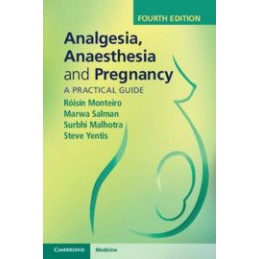Opis
Now in its fourth edition, Analgesia, Anaesthesia and Pregnancy is a concise guide to obstetric anaesthesia and analgesia. This essential text reviews every topic and clinical challenge faced during delivery and focuses on pre-empting problems and maximising quality of care. It also covers acute emergencies related to pregnancy. This new edition features eleven new chapters that cover the significant updates in the field over the last few years. Presented in a clearly structured format, this practical guide will be an invaluable source of key information for any anaesthetist encountering obstetric patients, whether they are a practised consultant or still in training. Obstetricians, neonatologists, midwives, nurses, and anaesthetic assistants in obstetric analgesia and anaesthesia who wish to extend or update their knowledge will also benefit from reading this book.
Szczegóły produktu
Indeks
80841
EAN13
9781108710527
ISBN
9781108710527
Opis
Rok wydania
2019
Numer wydania
4
Oprawa
miękka foliowana
Liczba stron
546
Wymiary (mm)
156.00 x 234.00
Waga (g)
940
1. Assisted fertility; 2. Ovarian hyperstimulation syndrome; 3. Anaesthesia before confirmation of pregnancy; 4. Ectopic pregnancy; 5. Evacuation of retained products of conception; 6. Termination of pregnancy; 7. Cervical suture (cerclage); 8. Incidental surgery in the pregnant patient; 9. Intrauterine surgery; 10. Anatomy of the spine and peripheral nerves; 11. Physiology of pregnancy; 12. Antenatal care; 13. Aortocaval compression; 14. Gastric function and feeding in labour; 15. Drugs and pregnancy; 16. Placental transfer of drug; 17. Prescription and administration of drugs by midwives; 18. Local anaesthetics; 19. Normal labour; 20. Intrapartum fetal monitoring; 21. Pain of labour; 22. Non-pharmacological analgesia; 23. Inhalational analgesic drugs; 24. Systemic analgesic drugs; 25. Intravenous patient-controlled analgesia for labour; 26. Epidural analgesia for labour; 27. Epidural test doses; 28. Spinal analgesia; 29. Combined spinal-epidural analgesia and anaesthesia; 30. Spinal and epidural opioids; 31. Pre-operative assessment; 32. Operative vaginal delivery (instrumental delivery); 33. Caesarean section; 34. Spinal anaesthesia for caesarean section; 35. Epidural anaesthesia for caesarean section; 36. General anaesthesia for caesarean section; 37. Cricoid pressure; 38. Failed and difficult intubation; 39. Awake intubation; 40. Removal of retained placenta and perineal suturing; 41. Postoperative analgesia; 42. Enhanced recovery; 43. Bloody tap; 44. Dural puncture; 45. Postdural puncture headache; 46. Epidural blood patch; 47. Extensive regional block; 48. Inadequate regional analgesia in labour; 49. Breakthrough pain during caesarean section; 50. Backache; 51. Chronic pain post-caesarean section; 52. Horners syndrome and cranial nerve palsy; 53. Peripheral nerve lesions following regional anaesthesia; 54. Spinal cord lesions following regional anaesthesia; 55. Arachnoiditis; 56. Cauda equina syndrome; 57. Opioid-induced pruritus; 58. Shivering; 59. Aspiration of gastric contents; 60. Awareness; 61. Air embolism; 62. Malignant hyperthermia; 63. Induction and augmentation of labour; 64. Oxytocic and tocolytic drugs; 65. Premature labour, delivery and rupture of membranes; 66. Malpresentations and malpositions; 67. External cephalic version; 68. Multiple pregnancy; 69. Vaginal birth after caesarean section; 70. Under-age pregnancy and advanced maternal age; 71. Abnormal placentation; 72. Placental abruption; 73. Cord prolapse; 74. Fetal distress; 75. Shoulder dystocia; 76. Intrauterine death; 77. Uterine inversion; 78. Major obstetric haemorrhage; 79. Postpartum haemorrhage; 80. Collapse on labour ward; 81. Maternal cardiopulmonary resuscitation; 82. Amniotic fluid embolism; 83. Cholestasis of pregnancy (obstetric cholestasis); 84. Acute fatty liver of pregnancy; 85. HELLP syndrome; 86. Hypertension, pre-eclampsia and eclampsia; 87. Magnesium sulphate; 88. Hyperemesis gravidarum; 89. Maternal mortality; 90. Allergic reactions; 91. Cardiovascular disease; 92. Arrhythmias; 93. Pulmonary oedema; 94. Cardiomyopathy; 95. Coarctation of the aorta; 96. Aortic dissection; 97. Valvular heart disease; 98. Congenital heart disease; 99. Pulmonary hypertension and Eisenmengers syndrome; 100. Ischaemic heart disease; 101. Endocrine disease; 102. Diabetes mellitus; 103. Anaemia and polycythaemia; 104. Deep-vein thrombosis and pulmonary embolism; 105. Thrombophilia; 106. Coagulopathy; 107. Von Willebrands disease and haemophilia; 108. Disseminated intravascular coagulation; 109. Thrombocytopenia; 110. Lymphoma and leukaemia; 111. Haemoglobinopathies; 112. Connective tissue disorders; 113. Rheumatoid arthritis; 114. Cervical spine disorders; 115. Kyphoscoliosis; 116. Low back pain in pregnancy; 117. The parturient with chronic pain; 118. Neurological disease; 119. Meningitis; 120. Acute post-infective peripheral neuropathy (Gui


 Dostawa
Dostawa
 Płatność
Płatność
 Zwroty
Zwroty
